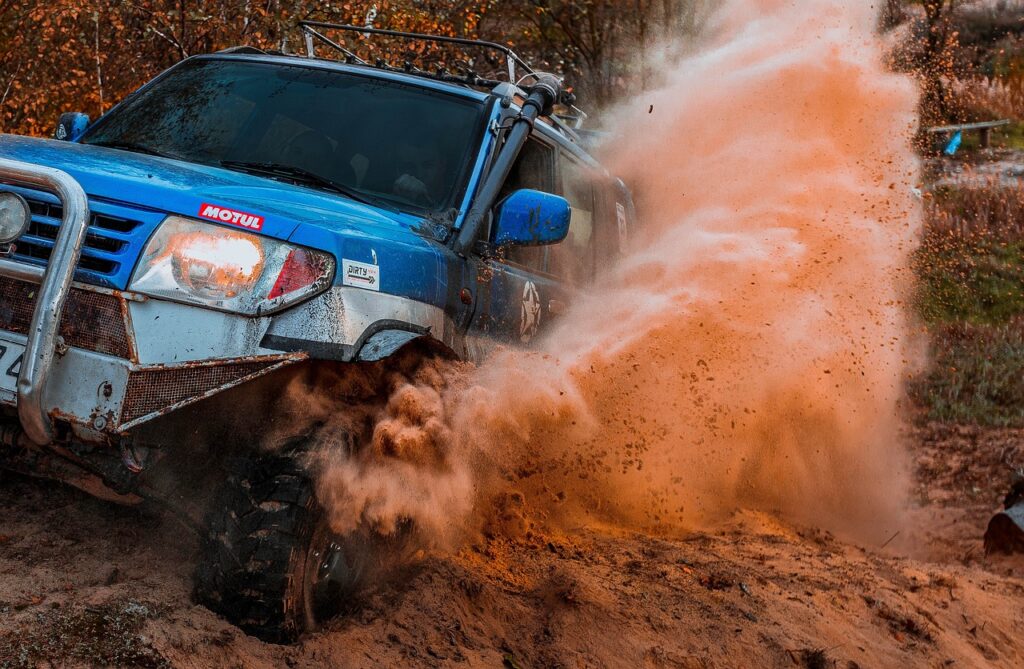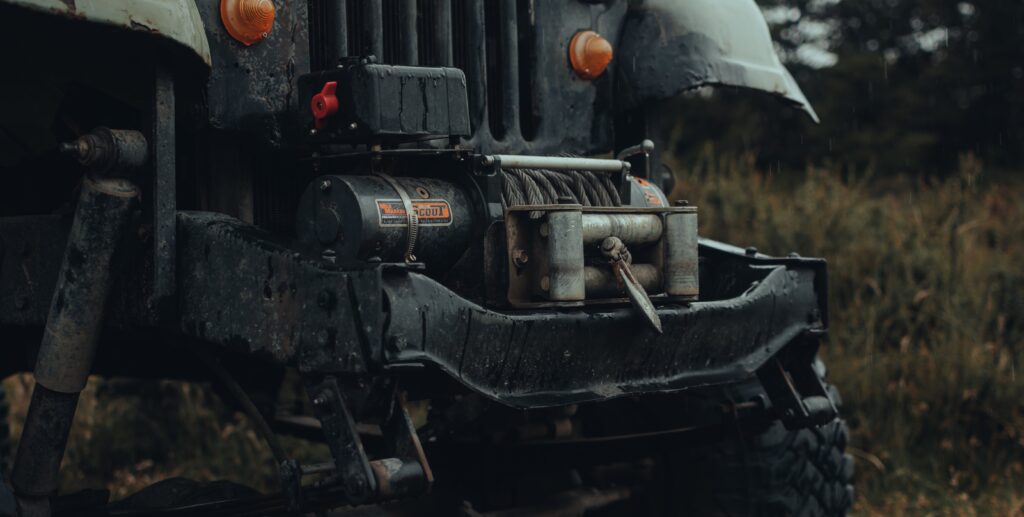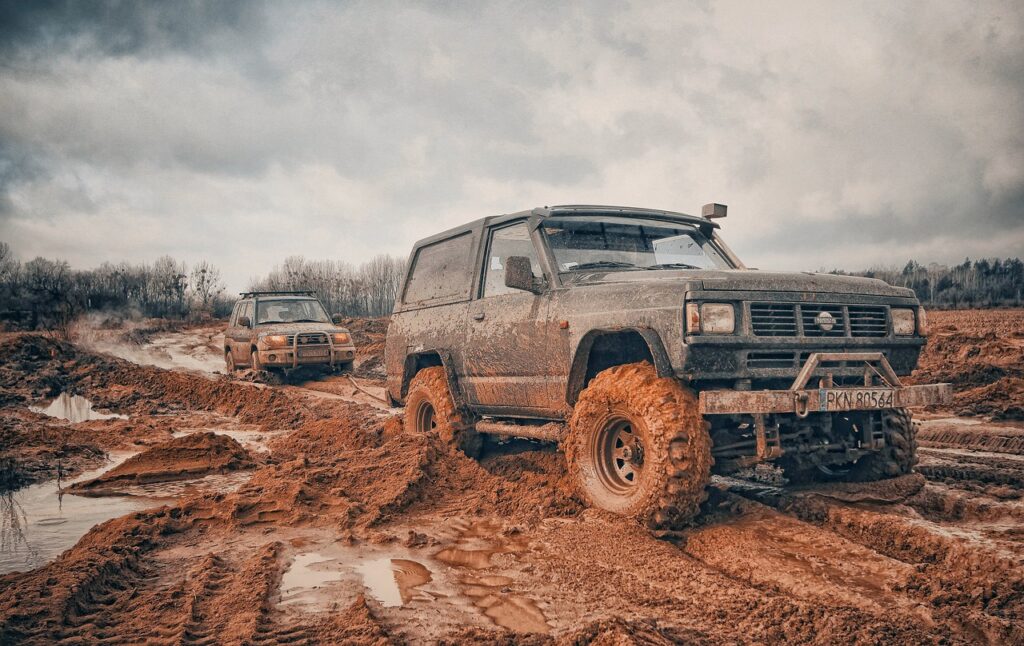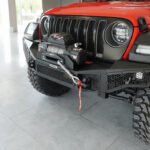
Your car prepared, destination set, ready to go… Not so fast. Hold your horses, especially the mechanical ones. Before you start your off-road adventure, equip yourself with recovery and towing accessories which will increase your safety. They’ll be useful if things get wild and you get stuck somewhere. Check out our essentials list and be prepared for a rescue mission.
Recovery ramps – made of steel, aluminum, or plastic. Effective tools for pulling out
The history of off-road recovery ramps (traction boards) has its roots in sailing. There, they serve as a boarding bridge, allowing a sailor to get from the dock to the deck. It’s not coincidental because our traction boards essentially do a similar job. Except in this case, it’s your off-road vehicle that takes on the role of the sailor. As part of recovery and towing accessories, they help vehicles regain traction in tough terrains.
Recovery ramps are a special kind of ramp that help dig out your wheels from the mud or sand and get onto more stable ground. Plus, these innocent pulling tools allow you to get out of the rugged terrain without a winch. Anyway, to get out of a tricky spot with traction boards, you need to place one end under the wheel of the stuck car and hit the gas.

Recovery ramps are theoretically one of the simplest rescue accessories, at least when it comes to using them. And if you’re determined, you can even make them yourself. Some even improvise traction boards from a ladder at home. Everyone knows those stories about the creative brother-in-law who can come up with incredible solutions when properly motivated. However, we prefer more tried-and-tested solutions. So, if you’re wondering how to make recovery ramps in your home workshop, you’ve got the wrong address.
4×4 recovery ramps – types and price
The most recognizable example of off-road recovery ramps are products from the Australian company Maxtrax. However, the cost for one pair of this model is close to 450 EUR. For some, this may seem like too much for this gadget at first glance. Especially since many drivers use traction boards to build bridges for crossings over ditches, and they are absolutely not designed for that purpose.
The most suitable type of ramps for this purpose are typically aluminum or Kevlar traction boards, which, due to their rigid construction, can support a vehicle over a rut. However, their flat surface has low traction in mud, which is definitely not ideal for us in the field. If that wasn’t enough, such recovery ramps easily accumulate mud, becoming heavy and, as a result, drowning. They are also uncomfortable to carry. Therefore, they will only be useful for crossing just before getting stuck, and preferably only once 😉
Another economical option is plastic traction boards. The cost for a pair is about 120 EUR. These are mainly suitable for sandy terrains. Their lightweight and less flexible structure will not work well with wet ground or swampy terrain, which require a more flexible form and solid grip on the surface.
The optimal solution is recovery ramps made of plastic material reinforced with nylon. Thanks to it, the construction gains the required flexibility and traction. A traction board with such features is easily placed under a spinning wheel. And this allows an exit from muddy terrain, sand, mud or snow. Additionally, their specially grooved surface aids in gripping the terrain. So, if you’re serious about off-roading full-time, investing in a set of these effective, durable, and convenient recovery and towing accessories will realistically cost about 250 EUR.
Traction boards and holders
Winch for off-road vehicles – Advanced recovery and towing accessories
Having a winch as part of your off-road vehicle’s recovering and towing accessories is essentially indispensable. You’ll be convinced of that when, despite our assurances, you decide to go off-roading for the first time with a factory stock vehicle without experience and any equipment – you will get stuck or suspended. It’s more certain than the fact that day follows night.

However, using a winch can initially be a challenge, and not following proper safety measures can even cause dangerous accidents. You could hurt yourself when handling the winch itself, or during the car pulling process.
The most dangerous situations are when you need to get out of a large ditch. We probably don’t need to explain what can happen if the rope breaks in such a situation. That’s why it’s so important to know how the winch works, how to use it properly, and to choose reliable and solid equipment. Forget about budget variants up to 500 EUR right away.
OFD electric winch
What kind of winch for off-roading?
There are various types of winches on the market: manual, mechanical, hydraulic, and specifically for 4×4 vehicles, i.e., electric winches. In off-roading, when pulling a vehicle out of deep mud, thick sand, floodplains, or other off-road troubles, an electronic winch is the only type of recovery and towing accessories you need to look for.
The most important factor when choosing a winch is its parameters, and there are a few key ones to consider. The first is the pulling rate capacity, measured in pounds (lbs) or kilograms (kg). This should match the weight of your vehicle, including everything inside or on it. So, it is recommended that the appropriate pulling rate capacity of a winch is one and a half times the final weight of the vehicle.
The second important parameter is the speed of the winch. It is determined by the power of its motor and the gear ratio. It is expressed in the number of motor revolutions relative to one drum revolution. The smaller the coefficient, the faster the winch winds the rope.
Read more
Steel or synthetic: Selecting the best winch rope for recovery and towing accessories
In the case of winches, the choice usually is between two types of ropes: steel and synthetic. The differences between them are significant, and the choice between them depends on individual preferences and user needs. So, which one is better?
Steel rope is known for its strength and durability. It is heavier than synthetic rope and more prone to rust and corrosion. Due to its metal construction, steel cable is less flexible than synthetic rope. Additionally, when under tension, it can store energy, which can be a danger if it snaps.
Rope for car winches
On the other hand, synthetic rope is much lighter than steel one. Additionally, synthetic rope floats on water and does not corrode. It is also more flexible and less dangerous in case of a break, as it has a lower recoil force, which reduces the risk of injury to the operator and people nearby.
In summary, the choice between steel and synthetic rope depends on the user’s preferences and the specific conditions in which it will be used. Each has its own advantages and disadvantages that should be considered before making a decision. However, synthetic rope is easier to maintain and safer to use.
How to install a winch
Installing an electric winch requires a special mounting plate, usually placed on or in the bumper, to support additional weight. Because of that, it’s crucial to use this plate rather than attaching the winch directly to the car’s factory parts.
In most cases, it’s best to have a specialist handle the installation. This ensures the winch is properly mounted to the front bumper and that the electrical wires are correctly connected. The positioning of components like the lever is also important, whether it’s reachable inside the vehicle cabin or closer to the winch itself. This ensures easy access, especially in emergencies when you may need to quickly cut off power to the winch.
Ideally, your mechanic should be familiar with the specific requirements of off-road vehicles and drivers to ensure a successful installation.
Hi-Lift accessories – how a car Jack works and how to use it correctly
An invaluable tool for navigating muddy terrain and replacing damaged tires is the hi-lift jack, a reliable manual alternative to hydraulic jacks. Originating from the American company Farm Jack and associated with the fire department, it suggests that we are dealing with reliable equipment designed for special tasks.
Exploring recovery and towing accessories: What is a hi-lift?
A hi-lift is essentially a lever placed on a vertical column, where pressing it causes the movement of the pawl mechanism, resulting in the locking of successive pins responsible for lifting the car. Therefore, to use a hi-lift, you only need the strength of your muscles. However, hi-lifts aren’t just for lifting; they’re versatile tools capable of spreading or pulling, making them a potential alternative to an electric winch.
Due to its versatility, a hi-lift jack is an indispensable part of the recovery and towing accessories for every off-road vehicle, especially lifted ones, where a standard jack may not suffice. It works great in the case of simple stuck situations, sinkings and wheel failures. It also performs very well in deep stuck situations when used in combination with recovery boards, especially in cases where additional digging under the wheel is required.
Additionally, when purchasing a hi-lift, it’s worth investing in a base for the jack itself and a wheel mount. This will definitely make it easier to lift the vehicle by the wheel, providing a more convenient and practical option compared to pulling the car out by the rockers or side panels, especially when the wheel is deeply buried.
Hi-lift and accessories
Safe lifting and lowering a vehicle with a Hi-Lift
To lift the vehicle using a hi-lift jack, first, move the lock and raise the lever to the approximate height needed. On the other hand, when lowering the vehicle, it is worth using an additional tool to unlock the lever mentioned earlier. Trying to do so manually with the hi-lift loaded with the weight of the vehicle would simply be dangerous.
Ensure the handbrake is engaged and the vehicle is in gear before using the hi-lift. Additionally, immobilize the front axle of the vehicle to prevent unintended movement. When lifting the car, position yourself on the opposite side of the lever and avoid approaching the working area of the jack. In case of any malfunctions or failures, having your hands or head in the path of the hi-lift could lead to tragic consequences.
Kinetic ropes, towing straps, and shackles – basic recovery and towing accessories

The simplest equipment of an off-road vehicle includes a kinetic rope, towing straps, and an additional fastener such as shackles, usually made of galvanized steel. However, even though this trio represents the most basic pulling tools in the rescue kit, their use should be approached with caution and careful consideration.
Which rope for an off-road vehicle
Most off-road drivers prefer a kinetic rope. Kinetic ropes are characterized by their low abrasiveness, resulting in high durability, great stretchability (sometimes exceeding 40%) and high breaking strength (sometimes exceeding 50,000 kg). Additionally, they are significantly lighter and softer compared to steel ropes.
Thanks to these properties, kinetic ropes work smoothly, transferring energy without causing the jerking effect. Therefore, using a kinetic rope potentially reduces the risk of damaging your car while pulling out. However, to prevent damage such as breaking the front windshield, it’s essential to tow in a straight line without adding extra load to the vehicle. In extreme situations, even a regular rope could stress the durability of your standard bumper.
Kinetic ropes
Why invest in towing recovery straps
A kinetic rope isn’t designed for towing vehicles, despite what many people think. Instead, kinetic rope is great for off-road situations like pulling vehicles out of ditches, mud, snow, or drifts by giving sudden tugs, which are known as “kinetic jerks,” to help free the stuck vehicle to get moving. However, using a kinetic rope for towing on asphalt is prohibited and highly risky. The elastic nature of rope can transfer its energy back to the vehicle. Potentially causing it to jerk forward and leading to a collision. Therefore, if you’re truly grounded and need to be towed straight to mechanic, towing straps are the appropriate choice. They aren’t accessories for pulling, but they are an essential part of off-road equipment. Of course, if you have someone nearby who can tow you.
Towing straps
Towing straps, typically made of tough polyester tape, boast a pull strength of up to 7.5 tons. Compared to kinetic rope they offer much lower stretchability. This combination provides the safest towing option, primarily because the risk of snapping is very low and the ability to handle heavy loads is very high. That’s why towing straps are durable and resistant to wear, even when they land under the solid wheels of an off-road vehicle equipped with MT tires.
Hard and soft shackles: Helpful recovery and towing accessories for secure connections
Shackles, like recovery boards, have their origins in sailing, where they are mainly used for securing lines. In off-roading, they serve as connectors for kinetic ropes and as the final link in an electric winch setup. For example, when extracting your off-road vehicle from mud and still needing to anchor to a nearby tree.
Traditionally, steel shackles have been the standard choice in off-roading. They often consist of a galvanized buckle with a semi-circular body, closed by a screw with a pin or a snap mechanism. The key advantage of steel shackles is their high durability, strength, and resistance to external factors. However, their weight can pose a significant risk. Especially when combined with a snapped rope.
D-ring and soft shackles
As a result, soft shackles, made of synthetic materials, are gaining popularity among off-roaders. While they have a lower load limit, they are appreciated for their lightweight and safety. For clarity, the load capacity of a synthetic shackle can be up to 16 tons, while a steel one can handle up to 150 tons. As you can see, the difference is quite significant. However, the woven version of soft shackles wears out faster in extreme conditions due to less resistance to abrasion. The choice between hard and soft shackles depends on your experience, skills, and personal preferences.



























Comments ()